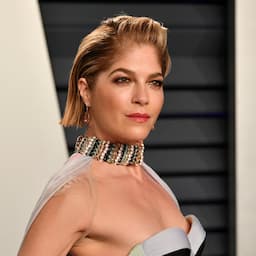The Discovery+ documentary is a deeply personal and emotionally raw account of the actress’ battle with multiple sclerosis.
Now streaming on Discovery+, Introducing, Selma Blair, is a deeply personal and emotionally raw account of the actress’ battle with multiple sclerosis, with the documentary chronicling the ups and downs of her undergoing HSCT, a bone marrow stem cell transplant. Directed by Rachel Fleit, the film is described as “one woman’s journey of personal acceptance and resilience” as Blair “reckons with the next chapter of her life after being diagnosed” in 2018. Filmed over several years, here’s everything the 49-year-old star says about her battle with MS, which is currently in remission, life and career.
Early Signs of MS
“Since my son was born, I’ve never been OK,” Blair candidly admits early on in the film when she’s discussing the first signs of her MS. “At first I knew I wasn’t doing well and I just kept going to the doctors. And they just said, ‘No. It’s just sadness...’ I was like, ‘I can’t get it together. I can’t function.’” Not long after that she became housebound and more reclusive in nature.
While she has felt off ever since the birth of her son, Arthur, in 2011, it wasn’t until 2018 that the signs of MS were more visible. One of the most notable indicators was when she walked the runway at Christian Siriano’s New York Fashion Week show in February 2018. “My leg did a horse stomp,” Blair says of the movement in her body she couldn’t control. “I was so apologetic to Christian.”
And in the summer of 2018, she was officially diagnosed with MS. And at the time, it was welcome news. “The truth is, the diagnosis came as a relief because then I could take steps,” Blair says.
Her Decision to Undergo HSCT
After that, however, things quickly deteriorated and the treatments available to her were not working or doing anything to slow down the MS. “The options ran out. A stem cell transplant is the thing that’s going to help me if anything will,” Blair says of eventually turning to HSCT.
However, after she made that choice, she reveals, “I made the mistake of telling someone... He was like, ‘You’re not going to make it.’” Since then, she realized she could only focus on herself and what was the right choice for her. “I’m afraid to talk about it because I don’t know what to expect,” she says.
As it is explained in the film, the hope is that within a year of the treatment, that Blair could be running, jumping or even horseback riding. But to get there is a long and hard process involving multiple steps of chemotherapy and isolation as her immune system deteriorates -- and this is all before the transplant takes place.
During one of the stages, she reveals that “had a horrible complication,” which involved losing her vision and intense pain before she passed out. But it was at that moment, she recalls, that she thought of her son and realized she wasn’t ready to die yet.
Later, when Blair is forced to go into isolation at the hospital, she chronicles everything on her cellphone. “I don’t feel great. That’s for sure,” she says at one point, admitting that “it’s a bad day.” Later, she bounces back as the transplant day nears. “It’s weird. I feel like I’m on set, an abandoned set,” she says during the transplant process.
Even though the transplant was successful, she experiences setbacks, like going outside, which overstimulates the MS or feeling like she can’t speak properly when having a conversation versus reading something. “It’s going to be a lot of my brain adjusting,” she says, before later admitting that she thought the transplant “didn’t totally work.”
However, three months after the transplant, the doctor reveals there are no new lesions. And she soon discovers that her recovery could take as long as two years before she starts to feel normal again. “The brain has to be relaxed and free to build new pathways,” she says.
Her Son
Throughout the entire process, Blair says that the only thing that matters to her most is her son. “If there’s an option to halt this, a time to rebalance after being hit so hard after my last flare, it’s absolutely for my son,” the actress said while promoting the film earlier this summer. “I have no desire to leave him alone.”
In the documentary, she recounts several heartbreaking stories, including one scary moment that made headlines in 2016. “I went on this trip with Arthur and his dad,” Blair says, revealing it was the first time they were all together after a contentious time in their lives. As a result, she spent most of the trip drinking in her hotel room. “It is the worst thing I’ve ever done as a parent... And thank God no one was hurt.”
However, on the plane ride home is when “I had a full-on blackout,” Blair says, noting that she already had MS at the time and that one of the symptoms was that her body always felt like it was on fire.
While she publicly apologized, she was worried that Arthur’s father, Jason Bleick, would take him away. “I was so grateful he did not try to take my child away from me,” Blair confesses. “That was one of the darkest moments of my life.”
Later, as Blair is preparing to go to Chicago for her stem cell therapy, she asks her son if anything made him nervous about her trip. “He said, 'I don’t want you to lose your hair,'" she recalls. So, she had him cut it before she left town so it wouldn’t be a shock to him when she returned. “I’m fine with my hair being gone,” she says.
While speaking to ET at the film’s premiere, Blair explained why she did that with her son. “The other night I asked him and he didn't even really remember the conversation. There is so much I realize he was really young and he didn’t remember,” she said, “But it was [important] to have him be a part of it, help him be in control of maybe like the first image of Mom looking different.”
“It a nice moment and it makes me feel better knowing Arthur is included,” she added.
Her Career
Early in the film, Blair reflects on her career and how she fell into acting. “I thought I wanted to be a writer,” she says, before revealing that her English teacher at the time told her that she should be an actor instead.
Despite breaking out with Cruel Intentions, her first studio film in her career, and appearing in films like Legally Blonde, The Sweetest Thing, Hellboy in rapid succession, Blair never felt like the lead. “I was always conscious I was just a supporting actress. Everything I did on set was to support the star,” she says, before admitting, “I was happy for things not to be so hard.”
Later in the film, Blair confesses that she “never had the hunger for being the best actress I could be. I would now, if I went back.” However, when asked if she thinks she’s ever going to act again, she says, “No. I don’t know... I don’t know who would believe in me.”
While speaking to ET, Blair said that she has “definitely gone through a good 10 to 15 years, really since Hellboy 2 wrapped, of not really finding my way, not feeling well, dealing with depression.”
As a result of “a few bad situations, things just kind of piled up and kind of had me lose some of my energy [for] acting and how I felt about it, although it is huge to me,” she admits now. “It is so important to me that I just know that there is no way I want to go back to hustling to find any job, which is amazing that I think I did as a young person because that was what I was taught.”
And as she says in the film, she’s worried she can’t handle long days on set and if that would adversely affect her recovery, even though one of her doctors suggests that work can be therapeutic.
“I would have to have someone work with me and find the right thing,” Blair says now. “I absolutely love acting. I love being a part of these sets... I mean, I do love it. I’m not saying, ‘Oh, I’m done. But I know the reality -- I went through a lot.” And if she did ever return to a set, it would have to be “to be important.”
Finding Humor and Being a Voice for Others
“Disabled people like to have fun too,” Blair says early on in the film as she pretends to have tiny hands. “I’m not disabled and I don’t care because I don’t have tiny, rubber hands.”
“I gotta laugh,” she says at one point. For her, it’s a way to channel that negative energy out of her head and not be weighed down by the darkness of her prognosis. “I don’t have anger anymore,” she adds.
“I always thought I was on a reality show... Like, I was in a documentary but only God would see it, and disapprove,” she says at one point. “But I hope now I’m just going to be a better person. And I hope when I feel better, I really hope to be a better person. That’s all I care about now.”
While she continues to fight MS and chronicle her ups and downs on Instagram (and document it all for the film), Blair admits she “never thought I would be a disabled person that would help other disabled people.”
“We have a long time to be dead. And I spent so long trying to kill myself... and now, I just wanna help other people feel better,” Blair says later, revealing that inspiring others has inspired her. “They saw themselves and they saw some hope. And just that act gave my life some meaning,” Blair says.
Her Final Words in the Film
“I’m embarrassed to say I’m at peace,” Blair says in the final moments of the film. “I hope, before I die, I really will have made a contribution for the people we live with.”
When asked about what she said, Blair told ET that she was embarrassed “because my whole life I wore, as a badge of honor almost, that I was cynical. That I was one that hadn’t found peace. I didn't purposely wear it as a badge of honor, but that was something my mother taught me.”
As for those final words about having made a contribution, Blair hopes it validates people who are going through what she’s gone through. “This can be validating for a lot of people. All of us, we really do all have a challenge all the time and so this can this can fit into anybody’s box to be some type of reassurance and, you know, affirmation that you can be scared, that you can have better days ahead, that you can want to live,” she explained.
“I never wanted to die but I didn’t want to live. Do you know what I mean? I was too scared to die. So, this is really a step of like, ‘No, I am making this change with the end of life, what we have,’” Blair concluded.
RELATED CONTENT


